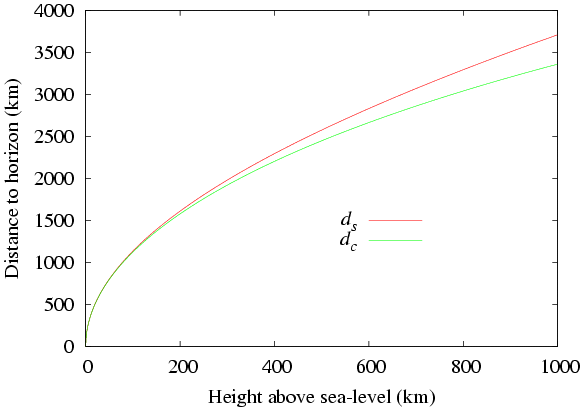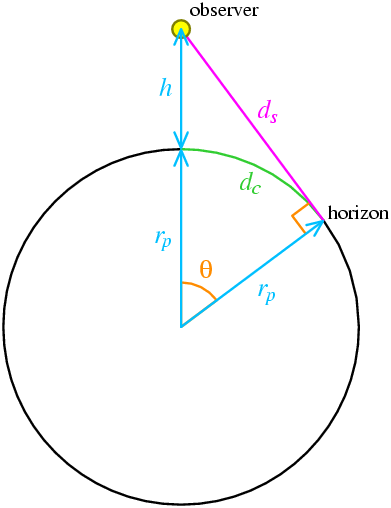Note: This page seems to be quite often the top search result for my name, but believe it or not, I don't spend all of my time calculating the distance to the horizon. Visit my main page for contact details, information on my research, etc.
Question
How far away is the horizon?
Answer
The answer depends on whether you define the distance as the straight, line-of-sight distance (from your eyes to the horizon), or as the distance along the planet's surface from the nearest point on the surface directly beneath your feet (well, straight down to sea level) to the horizon (i.e. the distance that you'd have to walk to get there).
At a height h above the surface of a spherical planet of radius rp:
The straight-line distance to the horizon:

The curved distance along the planet's (sea-level) surface to the horizon:

Of course, for small heights relative to the radius of the planet, these two are approximately equal.
Calculator
Enter the height above the surface and the radius of the planet (Earth is given as an example) to calculate the distance to the horizon using the above two formulae:
Example: the Earth
The equatorial radius of the Earth is approximately 6,378.14 km, hence rp = 6.37814×106 m. The following table gives the distance to the (sea-level) horizon for various heights h above sea level at the Earth's equator:
| Height h (m) | ds (m) | dc (m) | Notes |
|---|---|---|---|
| 1 | 3,571.59 | 3,571.59 | |
| 1.5 | 4,374.29 | 4,374.29 | Average eye-level |
| 10 | 11,294.37 | 11,294.36 | Different methods diverge by 1 cm |
| 100 | 35,716.07 | 35,715.70 | |
| 1,000 | 112,948.13 | 112,936.33 | |
| 8,851.5 | 336,140.69 | 335,829.99 | Standing on top of Mount Everest |
| 9,144 | 341,653.39 | 341,327.17 | Aircraft cruising at 30,000 feet |
| 100,000 | 1,133,855.37 | 1,122,132.49 | The Kármán Line, or "edge of space" |
As can be seen from the following graph, the two methods give similar answers until very large heights above sea level, and certainly for heights within the Earth's atmosphere:

Derivation
The geometry of the problem is the following, with a large height h drawn above the planet's surface for clarity:

The horizon is the point at which your line of sight will just touch the surface of the planet, which will be at right angles to a line along the planet's radius.
The straight-line distance
From doing Pythagoras on the right-angled triangle, we get find that (rp + h)2 = ds2 + rp2. Solving this for ds, we get:

The curved surface distance
- When θ is measured in radians, the subtended arc of the circle dc has a length dc = rp θ.
- From the adjacent and hypoteneuse of the right-angled triangle, we see that cosθ = rp / (rp +
h),
so that θ = cos-1[rp / (rp + h)].
Putting (2) into (1), we get our answer:

Checking
It's nearly always useful to check the validity of an equation by putting in extremal values and looking at the output.
First let's check these equations by using a height of zero, i.e. the observer's eye is embedded in the ground. The equation for ds becomes √[0 × (2rp + 0)] = 0, while the equation for dc becomes rp × cos-1[rp / (rp + 0)] = rp × cos-1[1] = rp × 0 = 0. So both equations return zero distance to the horizon in the case of zero height, which makes sense.
Now let's see the effect as the height h tends to infinity, i.e. we are racing away from the planet and looking back at it. By using h = ∞ (and admittedly a bit of a loose treatment of infinities), the equation for ds becomes √[∞ × (2rp + ∞)] = √[∞ × ∞] = √[∞2] = ∞, i.e. the horizon is an infinite straight-line distance away, which makes sense. For the curved portion of the planet's surface, dc becomes rp × cos-1[rp / (rp + ∞)] = rp × cos-1[rp / ∞] = rp × cos-1[0] = rp × π/2 = ˝(πrp) = Ľ(2πrp) = Ľcp where cp is the circumference of the planet. This is also sensible, because if you started from a point on a planet's surface and rose higher and higher above it, the furthest you would ever see along its surface in one direction would be one-quarter of the way around its circumference.